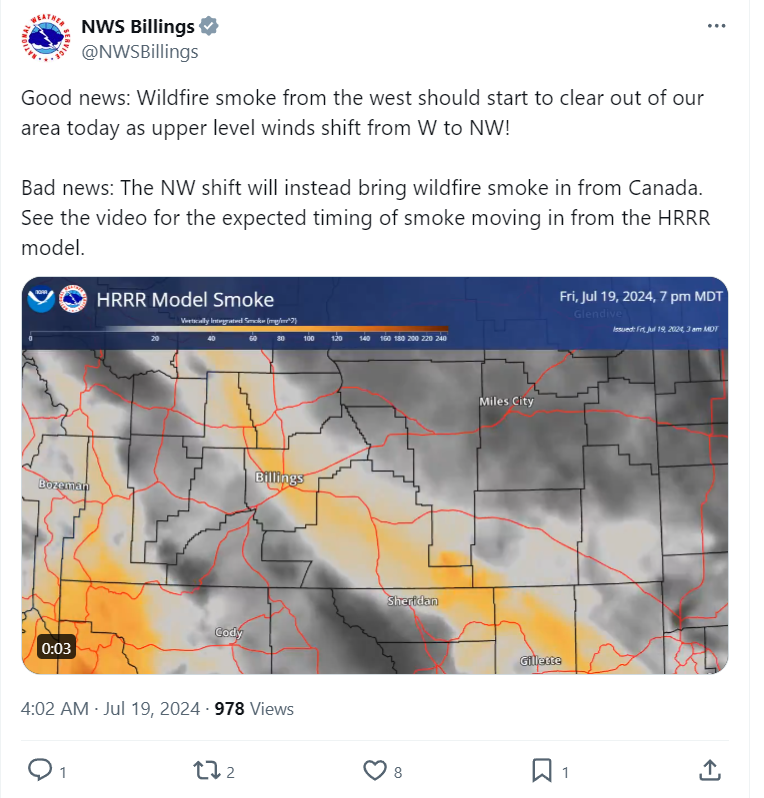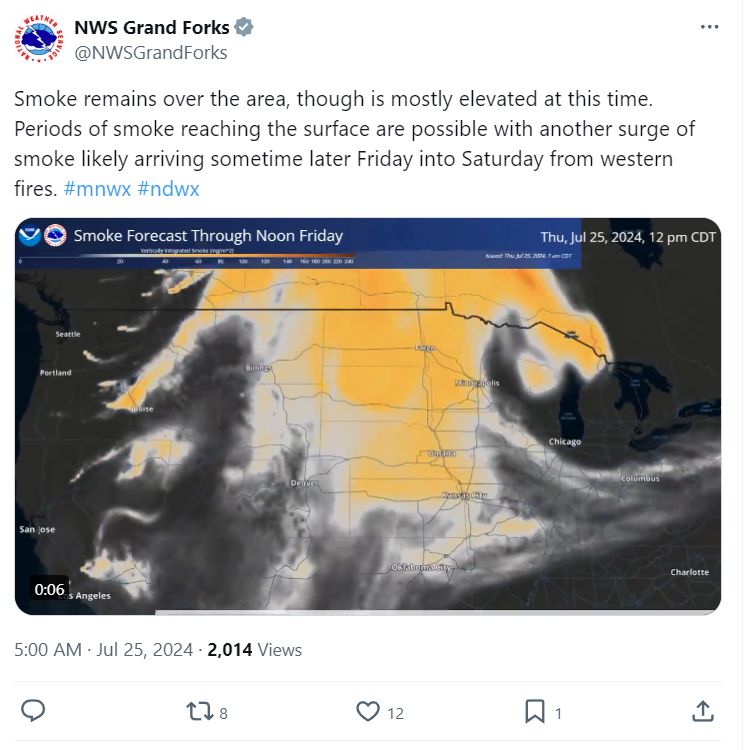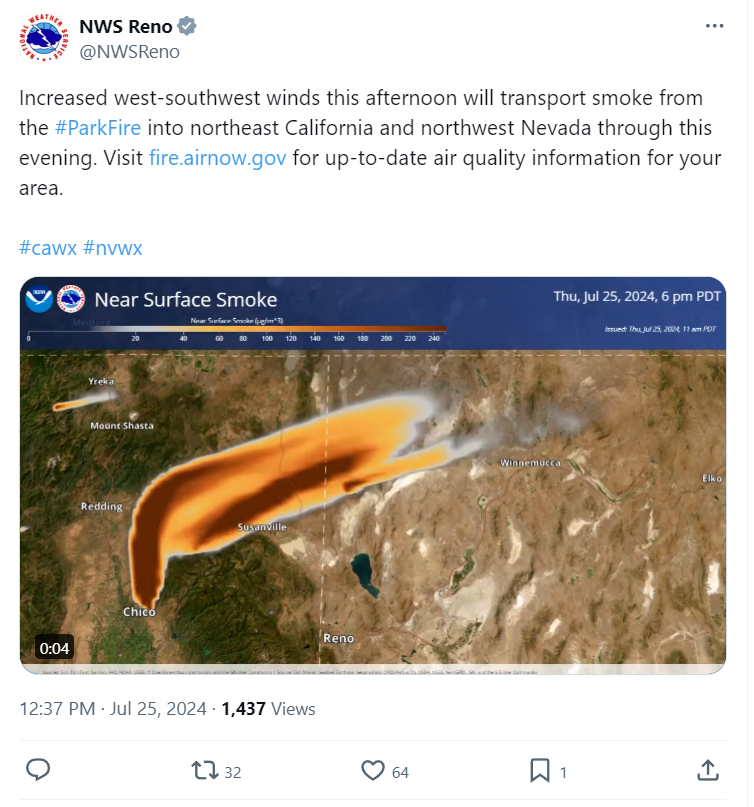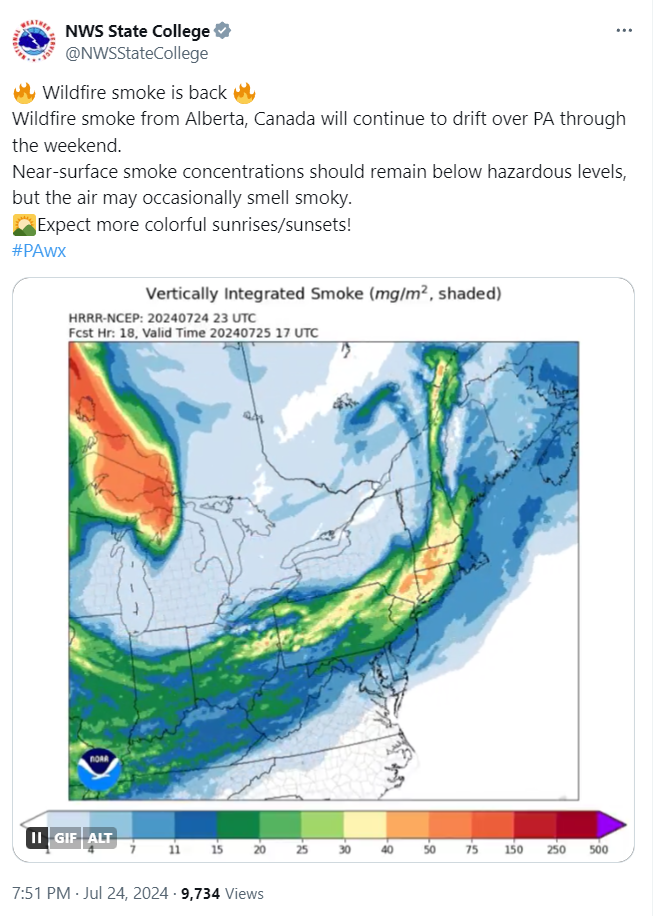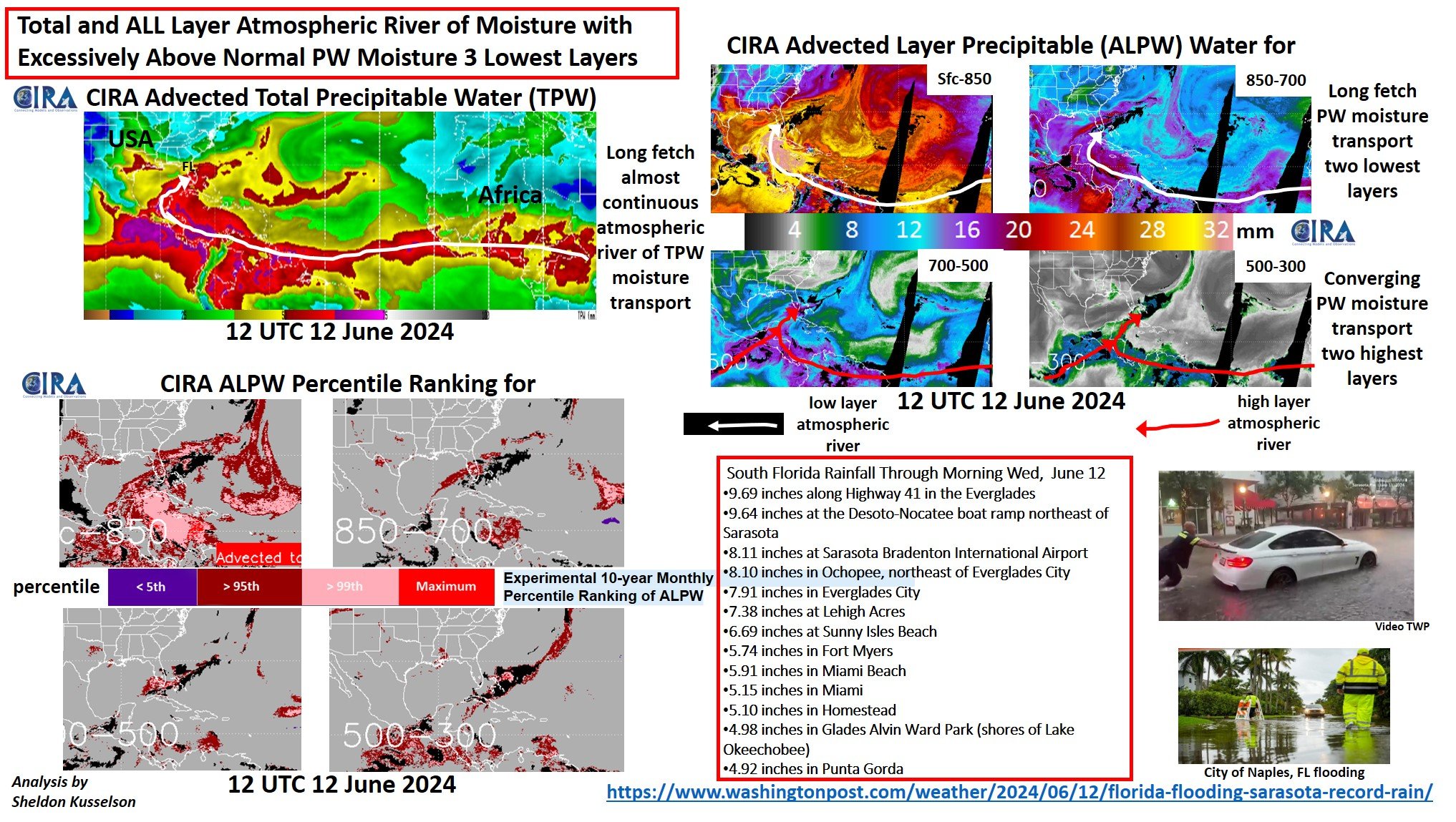Mountain Fire, California
November 8th, 2024 by Jorel TorresOn the morning of 6 November 2024, the Mountain Fire erupted, and fueled by strong winds, the fire spread southwestward towards cities located along the California coastline. The GOES-18 GeoColor product (see below) observed the fire and the corresponding smoke plumes from ~18-21Z, 6 November 2024. The narrow, long, smoke plumes advected westward offshore and eventually inundated the neighboring Anacapa, Santa Cruz and Santa Rosa islands.
Over the same time period, the GOES-18 Fire Temperature RGB provided a qualitative estimate of the fire intensities of the Mountain Fire. The RGB depicts fire pixels as red, orange, yellow and white colors. The red colors exhibit “warm fires”, orange colors as “very warm fires”, yellow colors as “hot fires” and white colors as “very intense fires”. Notice the rapid change in fire intensities and the fire spread towards the coastline.
At approximately 20:43Z, 6 November 2024, the VIIRS instrument on-board the NOAA-20 satellite captured the Mountain Fire at a high spatial resolution of 375-m. The VIIRS Day Fire RGB (bottom-left) depicts the active fires (red colors) and the smoke seen in blue over Oxnard, CA (and offshore) while the quantitative VIIRS Active Fires product (bottom-right) shows the fire intensity (i.e., Fire Radiative Power, FRP) values expressed in MegaWatts (MW). Note, the VIIRS Active Fires product exhibits yellow to dark red fire pixels that indicate increasing fire intensity values, where yellow pixels indicate “cooler fires” and dark red pixels as the “most intense fires”.
VIIRS Day Fire RGB (a.k.a., Day Land Cloud Fire RGB) and the VIIRS Active Fires product

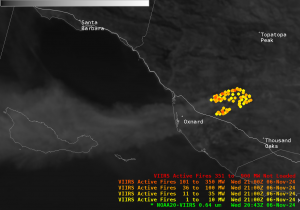
Given a closer look at the fire intensity values, forecasters can utilize the sample function in AWIPS, where the cursor readout values show several characteristics of the fire pixels: the time stamp, the polar-orbiting satellite, the fire confidence intervals (i.e., low, nominal or high), and the FRP values expressed in MW.
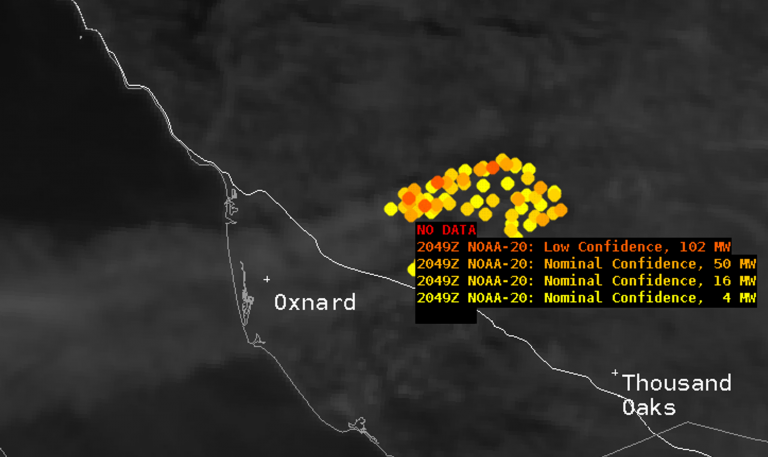
As of 8 November 2024, the Mountain Fire burned 20,000+ acres that included dozens of structures, and led to mass evacuations of homes, schools and businesses. The fire is 7% contained. To further monitor the Mountain Fire, users can refer to the CalFire webpage.
Posted in: AWIPS, Fire Weather, GOES, POES, Satellites, VIIRS, | Leave a Comment
Park Fire, California
August 7th, 2024 by Jorel TorresThe Park Fire in California initiated two weeks ago and portions of the fire perimeter are still ablaze at the time of this blog entry. As of 7 August 2024, the Park Fire has burned 420,000 plus acres and is only 34% percent contained (per InciWeb). The JPSS SNPP VIIRS Day Fire RGB and the VIIRS Fire Temperature RGB imagery observed the Park Fire on 6 August 2024 at 20:40Z.
The Day Fire RGB shows the extensive burn scar (reddish brown colors) produced by the Park Fire, along with active fire hotspots (seen in red colors) and the corresponding smoke plume (blue-grey colors). The VIIRS Fire Temperature RGB can also be employed for fire detection and provides a qualitative estimate of fire intensity. In the Fire Temperature RGB imagery, red pixels indicate ‘warm’ fires, orange pixels are designated as ‘very warm’ fires, yellow pixels are ‘hot’ fires, and white pixels are ‘very intense’ fires. On the northeast periphery of the Park Fire, a mix of yellow and white pixels can be seen, indicating that hot and very intense fires are present. The VIIRS Day Fire RGB is at a 375-m spatial resolution, while the VIIRS Fire Temperature RGB is at 750-m.

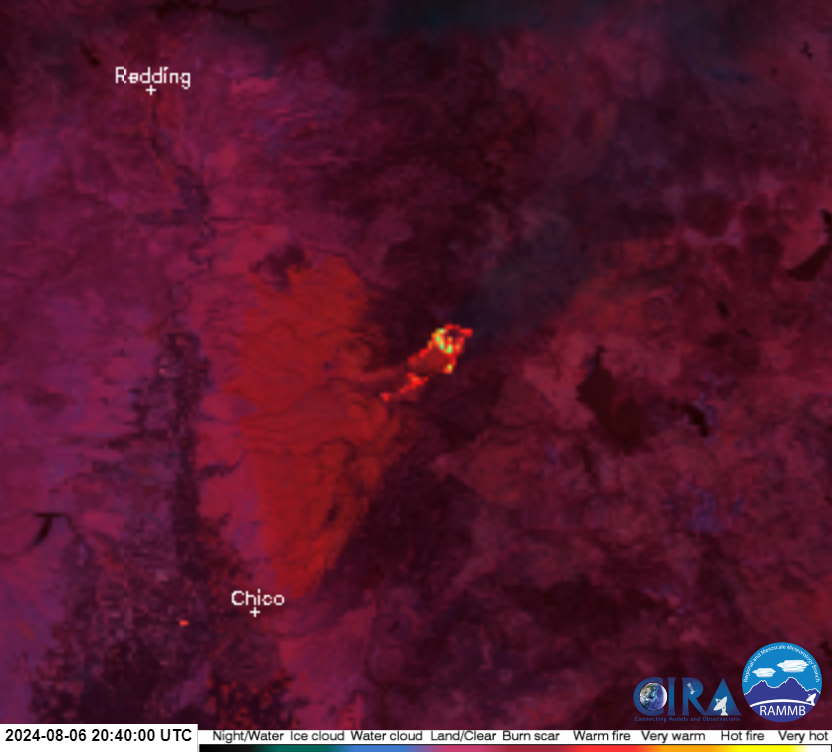
A daytime VIIRS Day Fire RGB animation of the rapid fire spread, smoke, active fires and burn scar can be seen below. The daytime animation spans two weeks, from 24 July 2024 to 5 August 2024.
Posted in: Fire Weather, POES, Satellites, VIIRS, | Leave a Comment
Smoky skies over Canada and the U.S.
July 25th, 2024 by Jorel TorresOver the past few weeks, fires have erupted and spewed high concentrations of smoke over western Canada and the United States. To exacerbate the situation, more fires initiated recently in the western U.S. National Weather Service (NWS) Weather Forecast Offices (WFO) highlighted the High-Resolution Rapid Refresh (HRRR) – Smoke products on social media to warn about the forecasted high smoke concentrations that can lead to human health impacts, bad air quality and reduced visibilities. A few of the WFO social media posts are seen below.
Some of the HRRR-Smoke products that were showcased on social media were the Near-Surface Smoke and the Vertically Integrated Smoke products that include inputs from MODIS and JPSS VIIRS Fire Radiative Power (FRP) data. The products exhibit a 3-km spatial resolution and are updated every hour. Forecast lead times are 48-hours at 00Z, 06Z, 12Z and 18Z, and 18-hours at other times of the day. Users can learn more about the HRRR-Smoke products here.
The HRRR-Smoke products are available online and in the Advanced Weather Interactive Processing System – II (AWIPS-II) for NWS forecasters. Note, HRRR-Smoke cross-sections are also available for certain domains. Refer to the animation below displaying the forecasted smoke concentrations (near the surface and aloft) within the NWS – Boulder, CO, County Warning Area (CWA) on 24 July 2024. HRRR-Smoke cross sections can be accessed here.
Posted in: AWIPS, Fire Weather, MODIS, NWS WFOs, POES, Satellites, VIIRS, | Leave a Comment
Canadian Wildfires
July 19th, 2024 by Jorel TorresAnother summer and another round of wildfires and smoke that inundate the Canadian provinces and territories. From 19-21Z, 17 July 2024, VIIRS GeoColor observed the smoke and fires extending from British Columbia to Hudson Bay. A daytime animation of VIIRS overpasses from SNPP, NOAA-20, and NOAA-21 can be seen below.
At ~09Z 18 July 2024, the SNPP VIIRS Near-Constant Contrast (NCC) product captured the emitted lights from the fires and the neighboring towns and cities. The nighttime visible imagery also observed a mix of smoke and clouds over the Canadian provinces. The use of nighttime visible imagery is unique, especially for the detection of smoke at night, which is challenging to observe in the infrared channels. Refer to the SNPP VIIRS NCC image below.
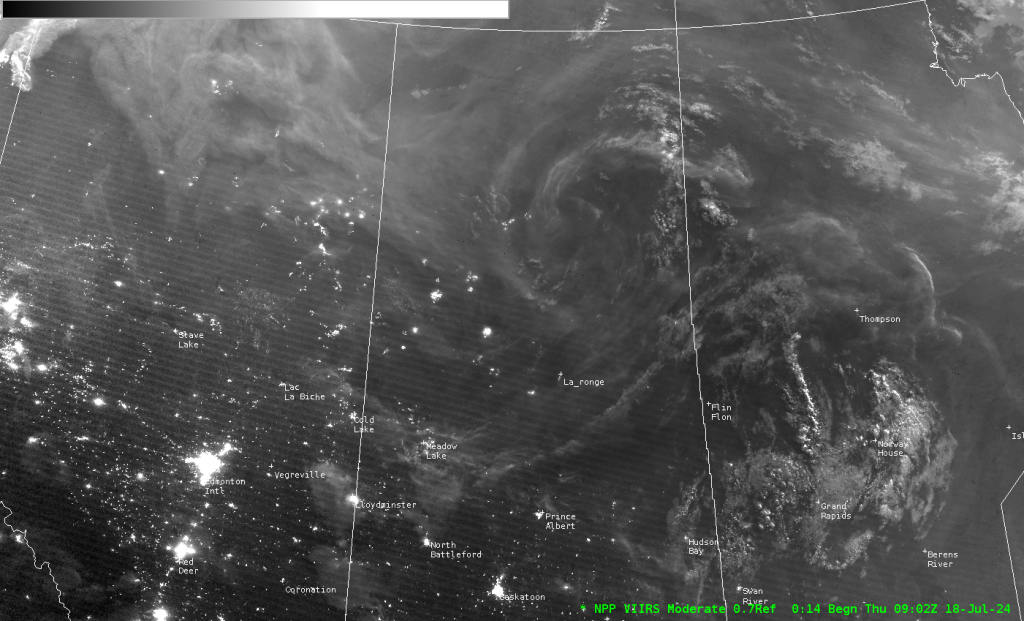
Note, forecasters can modify the VIIRS NCC color table in AWIPS-II, which can be customized to bring out features in the imagery (in this case, the smoke and clouds). A comparison of two NCC imagery enhancements, the default NCC 0-to-1 scale and the 0-to-0.7 scale are seen below at ~9Z, 18 July 2024. The 0-to-0.7 NCC enhancement helps illuminate the smoke and clouds, but increases the saturation of the emitted lights. Forecasters should be aware of the different NCC enhancements (a.k.a., scales) and how they can bring out certain features more than others. Additional information on the NCC enhancements can be explored here.
If we focus on the emitted lights that are seen at ~9Z, 18 July 2024, how can forecasters differentiate between emitted lights that are produced from fires and the emitted lights produced from cities and towns? In the nighttime visible imagery, city/town lights can be detected via individual pixels or clusters, where fires are represented by bright pixels that tend to have a corresponding diffuse smoke plume.
Additional ways to locate emitted lights from fires is to overlay other datasets onto the NCC imagery (e.g., utilize the 3.74µm, Fire Temperature RGB, etc.). The animation below shows the VIIRS Active Fire product overlaid onto the VIIRS NCC data at ~9Z, 18 July 2024. The VIIRS Active Fire displays a range of colors, from yellow to dark red colors that indicate values of increasing fire intensity. The fire intensity is expressed in MegaWatts (MW). In the animation, notice the varying fire intensities across Canada and how they align with certain emitted lights. Also note the emitted lights that are not associated with the thermal hot spots, such as the city of Edmonton. Edmonton is seen as a cluster of emitted city lights that can be observed in the bottom left corner of the animation.
Posted in: AWIPS, Fire Weather, POES, Satellites, VIIRS, | Leave a Comment
12 June 2024 Florida heavy rainfall event
June 12th, 2024 by Dan BikosBy Sheldon Kusselson
Posted in: Heavy Rain and Flooding Issues, Hydrology, | Leave a Comment

